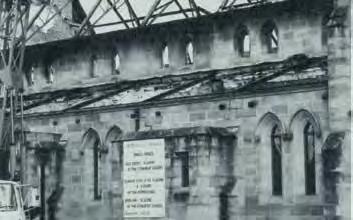
4 minute read
Blast from the past

Above: St Mar y’s Cathederal. The fire was first spotted at 9pm, but by 9.30pm the whole roof was on fire. Right: St Mar y’s Cathederal. Only the façade, the bell tower, and part of the north-east transept were left standing.


PHOTO: STATE LIBRARY OF NSW ILLUSTRATION: STATE LIBRARY OF NSW The burntout shell of St Patrick’s Cathedral, Parramatta, after the fire in 1996.
St Patrick’s, Parramatta, during the fire.
NSW CATHE DR AL CAL AMITIES – 1865 AND 1996
BY BARRY LEE OAM
he spectacular 2019 fire in the historic Notre Dame Cathedral,
TParis, focused international attention on the vulnerability of such heritage buildings. The fire engulfed the upper structure of the cathedral as it was undergoing renovations. It destroyed the 91-metre spire and the roof, threatened the twin medieval bell towers and prompted frantic efforts to salvage precious artefacts. The forest of 850-year-old roof timbers combined with the lack of automatic fire protection virtually ensured rapid fire development. Only dogged fire brigade work averted total destruction.
‘ What has happened can happen’
In 1985, the tower of Luxembourg’s main cathedral caught fire and burned down. In 2004, a fire in the Duchess Anna Amalia librar y in Weimar, Germany, caused an estimated €80 million damage. In Italy, the historic La Fenice Opera House was destroyed by fire and, a year later, the same happened at Turin’s Sindone Chapel of the Holy Shroud.
Australia is not immune and two NSW examples illustrate the point.
St Mar y’s Cathedral is the seat of the Archbishop of Sydney and is the world’s largest ecclesiastical building in the English Gothic style. The first St Mar y’s was built on land given to the church by Governor Macquarie, who laid the foundation stone in 1821.
All was lost on the night of 29 June 1865, when fire destroyed the cathedral, leaving only Augustus Pugin’s façade, the bell tower and part of the northeast transept. A contemporar y account stated that it was “by far the largest and most disastrous conflagration which has ever occurred in Sydney … and resulted in the total destruction of St Mar y’s Cathedral. This noble edifice which was one of, if not the finest, example of church architecture in the colony is now an unsightly ruin. The cost of the building, it is thought, could not be less 1than 50,000 pounds.”
It continued, “fanned by a strong westerly wind, the fire was first seen after nine o’clock. By half past nine the whole of the roof of the building was covered with flame. Parts of Hyde Park could be seen as distinctly as by daylight. The interior of the cathedral was a vast furnace of fire. The magnificent organ, costing originally upwards of 2,000 pounds, was destroyed in the general wreck. The ceiling, which was an imitation of the vaulted groined ceilings of the middle ages, was of polished cedar ; in many places it touched the roof—no sooner did the fire reach the former than it burst through the shingled
2portion of the latter.”
The fire in St Patrick’s Cathedral, Parramatta, “caused a great amount 3of despair in the community.” An earlier church was built on the site in 1854 based on a design by Pugin. In 1936, a new church was constructed, incorporating the tower and spire from the earlier building. It became a cathedral in 1986.
In 1996 a fire, the work of an arsonist, almost completely destroyed the building, leaving only the outside walls and tower standing. The fire caused an estimated $5 million damage. A new cathedral was opened in 2003, and the old cathedral is now the Blessed Sacrament Chapel.
St Patrick’s Cathedral in New York City, built in 1878, installed a partial water mist system during recent renovations. Washington National Cathedral, built in 1912, is installing automatic sprinkler protection as part of a renovation, spurred on by damage from a 2011 earthquake. And in Melbourne, a partial automatic sprinkler system is installed in St Paul’s Cathedral.
1. Sydney Morning Herald, June 30 1865. 2. If you walk along the eastern façade of St Mar y’s Cathedral, you will come upon an old wall at odds with the rest of the beautiful sandstone exterior. This fragile piece of the past is all that is left of the first church that burned down in 1865. 3. Brazell, M, 19 March 2011, ‘Parish Profile—St Patrick’s
Cathedral Parish, Parramatta’.














